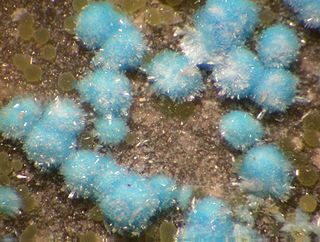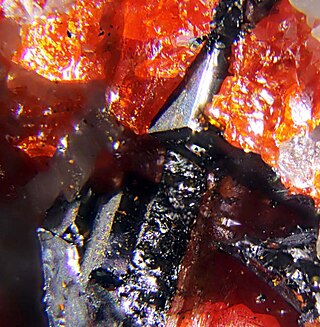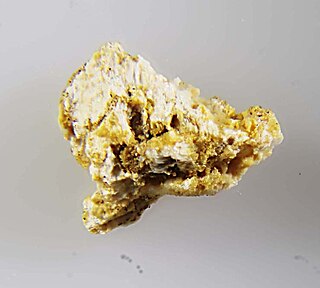
Tokyoite is a rare barium manganese vanadate mineral with the chemical formula: Ba2(Mn3+,Fe3+)OH(VO4)2. It is the manganese analogue of the iron rich gamagarite and the barium analogue of the lead vanadate, brackebuschite.

Nevadaite is a rare phosphate mineral with a chemical formula of
Feodosiyite is a very rare chloride mineral, just recently approved, with the formula Cu11Mg2Cl18(OH)8•16H2O. Its structure is unique. Feodosiyite comes from the Tolbachik volcano, famous for many rare fumarolic minerals. Chemically similar minerals, chlorides containing both copper and magnesium, include haydeeite, paratacamite-(Mg) and tondiite.
Heptasartorite is a very rare mineral with formula Tl7Pb22As55S108. It belongs to sartorite homologous series. It is related to other recently approved minerals of the series: enneasartorite and hendekasartorite. All three minerals come from a quarry in Lengenbach, Switzerland, which is famous of thallium minerals. Chemically similar minerals include edenharterite and hutchinsonite.

Enneasartorite is a very rare mineral with formula Tl6Pb32As70S140. It belongs to sartorite homologous series. It is related to other recently approved minerals of the sartorite series: hendekasartorite and heptasartorite. All come from Lengenbach quarry in Switzerland, which is famous for thallium sulfosalts. Enneasartorite is chemically similar to edenharterite and hutchinsonite.

Hendekasartorite is a very rare thallium sulfosalt mineral with formula Tl2Pb48As82S172. It is one of recently approved new members of sartorite homologous series, by enneasartorite and heptasartorite. All new members come from Lengenbach quarry in Switzerland, prolific in terms of thallium sulfosalt minerals. Hendekasartorite is chemically similar to edenharterite and hutchinsonite.

Fluorwavellite is a rare phosphate mineral with formula Al3(PO4)2(OH)2F•5H2O. As suggested by its name, it is a fluorine-analogue of wavellite (hence its name), a rather common phosphate mineral. Chemically similar aluminium fluoride phosphate minerals include fluellite, kingite and mitryaevaite.
Kyawthuite is a rare mineral with a simple formula: Bi3+Sb5+O4. It is a natural bismuth antimonate. Kyawthuite is monoclinic, with space group I2/c, and is isostructural with clinocervantite, its trivalent-antimony-analogue. Kyawthuite is also an antimony-analogue of clinobisvanite. Kyawthuite was discovered in the vicinity of Mogok in Myanmar, an area famous for its variety of gemstone minerals. Only one 0.3 gram sample of the naturally occurring form of this mineral has been found and is stored at the Natural History Museum of Los Angeles County.

Juansilvaite is a very rare, complex arsenate-sulfate mineral with formula Na5Al3[AsO3(OH)]4[AsO2(OH)2]2(SO4)2·4H2O. It is both hydroxyarsenate and dihydroxyarsenate. It is among few relatively new minerals from the Torrecillas mine in Chile, the other being torrecillasite, canutite, chongite, gajardoite, leverettite, and magnesiokoritnigite. Although having quite common among minerals space group C2/c, juansilvaite has a new type of structure.

Steinmetzite is a very rare phosphate mineral with formula Zn2Fe(PO4)2(OH)•3H2O. It was discovered among pegmatites of Hagendorf in Germany, that are famous for rare phosphate minerals. Steinmetzite is chemically related to phosphophyllite and other zinc iron phosphates, namely plimerite and zinclipscombite.

Cerianite-(Ce) is a relatively rare oxide mineral, belonging to uraninite group with the formula (Ce,Th)O
2. It is one of a few currently known minerals containing essential tetravalent cerium, the other examples being stetindite and dyrnaesite-(La).
Dyrnaesite-(La) is a rare-earth phosphate mineral with the formula Na
8Ce4+
(La,REE)
2(PO
4)
6. Dyrnaesite-(La) is related to vitusite-(Ce), another rare-earth phosphate mineral. It comes from lujavrite, a type of alkaline syenite rock, of South Greenland. Dyrnaesite-(La) is one of few known minerals with essential tetravalent cerium, the other two being cerianite-(Ce) and stetindite.
Faizievite is a very rare mineral with the formula K2Na(Ca6Na)Ti4Li6Si24O66F2. This triclinic mineral is chemically related to baratovite and katayamalite. Faizievite is a single-locality mineral, coming from the moraine of the Darai-Pioz glacier, Tien Shan Mountains, Tajikistan. Alkaline rocks of this site are famous for containing numerous rare minerals, often enriched in boron, caesium, lithium, titanium, rare earth elements, barium, and others.
Fluorcarmoite-(BaNa) is a rare phosphate mineral, belonging to arrojadite group, with the formula Ba[]Na2Na2[]CaMg13Al(PO4)11(PO3OH)F2. It is a barium-rich member of the group, as is arrojadite-(BaNa), arrojadite-(BaFe), fluorarrojadite-(BaFe) and an unapproved species ferri-arrojadite-(BaNa). The "-(BaNa)" suffix informs about the dominance of the particular elements (here barium and sodium) at the corresponding structural sites.
Hexacelsian is a rare barium silicate mineral with the formula BaAl2Si2O8. It was discovered in the Hatrurim Basin in Israel, where the Hatrurim Formation of rocks formed due to exposed pyrometamorphism.
Hermannjahnite is a rare sulfate mineral with the relatively simple formula CuZn(SO4)2. It is one of many fumarolic minerals discovered on the Tolbachik volcano.
Kainotropite is a rare vanadate mineral with the formula Cu4FeO2(V2O7)(VO4). It contains trivalent iron. It is one of many fumarolic minerals discovered on the Tolbachik volcano. The name of its parental fumarole is "Yadovitaya", which means poisonous.

Shumwayite is a rare but relatively simple uranyl sulfate mineral with the formula (UO2)2(SO4)2•5H2O. It was discovered in the Green Lizard and Giveaway-Simplot mines of the White Canyon mining district, San Juan County, Utah, US.
Wampenite is a rare organic mineral with the formula C18H16, found in Wampen, Fichtelgebirge, Bavaria, Germany.

Alvanite is a zinc nickel aluminium vanadate mineral with the chemical formula (Zn,Ni)Al4(V5+O3)2(OH)12·2H2O. It was originally discovered in the Karatau Mountains.









